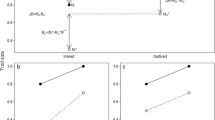Summary
Triple-testcross experiments were used to analyze epistatic contributions to % hatchability of eggs, age of pupation, number of eggs laid in 24-hour period, and survival from hatching to day 35. Seven diverse inbred lines and the F1 produced by crossing the two tester lines were examined for the presence of epistasis. There was evidence of epistasis for each of the 4 traits in at least one of the 8 lines tested. Epistasis was a major source of variation in survival in all of the lines tested.
Similar content being viewed by others
Literature
Arkin, H.; Colton, R.R.: Tables for Statisticians. 2nd. ed. Barnes and Noble, Inc. New York 1963
Goodwill, R.: An analysis of the mode of gene action affecting pupa weight in Tribolium castaneum. Genetic 79, 219–229 (1975)
Goodwill, R.E.; Walker, R.D.: Epistatic contributions to quantitative traits in Tribolium castaneum. I. Traits not closely related to fitness. Theor. Appl. Genet, xxx
Wright, S.: Evolution and the Genetics of Populations. Vol. I. University of Chicago Press, Chicago, Illinois. 1969
Author information
Authors and Affiliations
Additional information
Communicated by H. Abplanalp




